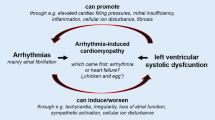Abstract
Ventricular fibrillation (VF) is by far and away the most common cause of early mortality in patients with acute myocardial infarction [12, 13]. This also applies equally to acute experimental coronary occlusion [12, 13]. Early mortality within the first 24 h attains a maximum in the 1st h and then drops exponentially. The mean interval between the onset of symptoms and sudden death is reported as 21 min [12, 13]. In experimental cardiology, we distinguish between two characteristic phases of arrhythmias following acute one-step coronary ligation [9]: an initial early phase lasting 20–30 min immediately following ligation and a second phase of arrhythmias after an interval of 6–10 h with few extrasystoles; this second phase lasts for a period of 24–48 h. The present study is an investigation of the first phase of arrhythmias described by Harris [9].
Supported by the Landesamt f. Wissenschaft u. Froschung, Düsseldorf, FRG.
Access this chapter
Tax calculation will be finalised at checkout
Purchases are for personal use only
Preview
Unable to display preview. Download preview PDF.
Similar content being viewed by others
References
Abendroth, R.-R., Meesmann, W., Stephan, K., Schley, G., Hübner, H.: Wirkung des β-Sympathikolytikums Atenolol auf die Arrhythmien, speziell das Kammerflimmern und die Flimmerschwelle des Herzens beim akuten experimentellen Koronarverschluß. Z. Kardiol. 66. 341 (1977)
Ablad, B., Carlsson, E., Dahlof, C., Ek, L.: Some aspects on the pharmacology of adrenergic β-receptor blockers. In: Pathophysiology and Management of Arterial Hypertension. Berglund, G., Hansson, L., Werkö, L. (ed.). Proc. Conf. Kopenhagen, Univ. Göteborg, pp. 152–166, 1975
Adler-Graschinsky, E., Langer, S.Z.: Possible role of a betaadrenoceptor in regulation of noradrenaline release by nerve stimulation through a positive feed-back mechanism. Br. J. Pharmacol. 53, 43 (1975)
Cranefield, P.F.: The Conduction of the Cardiac Impulse. New York: Mount Kisco 1975
Cranefield, P.F., Wit, A.L., Hoffman, B.F.: Conduction of the cardiac impulse. III. Characteristics of very slow conduction. J. Gen. Physiol. 59, 227 (1972)
Downar, E., Janse, M.J., Durrer, D.: The effect of acute coronary artery occlusion on subepicardial transmembrane potentials in the intact porcine heart. Circulation 56, 217 (1977)
Downar, E., Janse, M.J., Durrer, D.: The effect of “ischemic” blood on transmembrane potentials of normal porcine ventricular myocardium. Circulation 55, 455 (1977)
Haase, M., Schiller, U.: Zur zeitlichen Parallelität zwischen der Aktivität ektopischer Schrittmacher und dem Eintritt von Kammerflimmern nach Ligatur eines Hauptkoronarastes beim Hund. Acta Biol. Med. Ger. 23, 413 (1969)
Harris, A.S.: Delayed development of ventricular ectopic rhythms following experimental coronary occlusion. Circulation 1, 1318 (1950)
Höper, J., Kessler, M., Simon, W.: Measurements with ion-selective surface electrodes (pK, pNa, pCa, pH) during no-flow anoxia. In: Ion and Encyme Electrodes in Biology and Medicine. Kessler, M. et al., (eds.). München-Berlin-Wien: Urban & Sehwarzenberg 1976, 331
Lubbe, W., Bricknell, O.L., Podzuweit, T., Opie, L.H.: Cyclic AMP as a determinant of vulnerability to ventricular fibrillation in the isolated rat heart. Cardiovasc. Res. 10, 697 (1976)
Meesmann, W., Stephan, K., Schley, G., Gülker, EL: Zur Problematik einer Differentialtherapie der Arrhythmien beim akuten Herzinfarkt. Dtsch. Med. Wochenschr. 100, 954 (1975)
Meesmann, W., Stephan, K., Abendroth, R.-R., Menken, U., Wiegand, V.: Frühe Arrhythmien, insbesondere Kammerflimmern, nach akutem experimentellen Koronarverschluß und Beta-Rezeptorenblocker. In: Betablockade 1977. Mäurer, W., Schönig, A., Dietz, R., Lichtlen, P. (eds.). Stuttgart: Thieme 1977, p. 244
Meesmann, W., Schulz, F.W., Schley, G., Adolphsen, P.: Überlebensquote nach akutem experimentellem Coronarverschluß in Abhängigkeit von Spontankollateralen des Herzens. Z. Ges. Exp. Med. 153, 246 (1970)
Meesmann, W., Gülker, HL, Krämer, B., Stephan, K.: Time course of changes in ventricular fibrillation threshold in myocardial infarction: characteristics of acute and slow occlusion with respect to the collateral vessels of the heart. Cardiovasc. Res. 10, 466 (1976)
Menken, U., Wiegand, V., Meesmann, W., Stephan, K., Bucher, P.: Prophylaxe des Kammerflimmerns und verminderte Vulnerabilität des akut ischämischen Myokards durch chronische β-Blockade. Z. Kardiol. Suppl. 4, R 77 (1977)
Nayler, W.G.: Pharmacological protection of the hypoxic heart. 7 th Europ. Con. Cardiol. Amsterdam (20.–25.6.1976) p. 687
Pantridge, J.F., Webb, S.W.: Autonomic disturbance at the onset of acute myocardial infarction. In: Kardiale Sympathikolyse als therapeutisches Prinzip. Lydtin, H., Meesmann, W. (eds.). Stuttgart: Thieme 1975, p. 136
Reimer, K.A., Rasmussen, M.M., Jennings, R.B.: On the nature of protection by propranolol against myocardial necrosis after temporary coronary occlusion in dogs. Am. J. Cardiol. 37, 520 (1976)
Schley, G., Meesmann, W., Schulz, F.W., Amann, L., Tüttemann, J., Wilde, A.: Untersuchungen über den Einfluß von Spontankollateralen des Herzens auf die Herzrhythmusstörungen nach experimentellem Koronarverschluß. Arch. Kreislaufforsch. 67, 305 (1972)
Stephan, K., Meesmann, W.: Beeinflussung der frühen Arrhythmien nach akutem Koronarverschluß durch β-Blockade mit Practolol. Z. Kardiol. 63, 603 (1974)
Webb, S.W., Adgey, A.A.J., Pantridge, J.F.: Autonomie disturbance at onset of acute myocardial infarction. Br. Med. J. 3, 89 (1972)
Wiegand, V., Güggi, M., Meesmann, W., Kessler, M., Greitschus, F.: Extracellular [K+]e changes after acute coronary occlusion. Pflügers Arch. [Suppl.] 373, R17 (1978)
Author information
Authors and Affiliations
Editor information
Editors and Affiliations
Rights and permissions
Copyright information
© 1978 Springer-Verlag Berlin Heidelberg
About this chapter
Cite this chapter
Meesmann, W., Wiegand, V., Menken, U., Komhard, W., Rehwald, U. (1978). Early Mortality Due to Ventricular Fibrillation, and the Vulnerability of the Heart Following Acute Experimental Coronary Occlusion: Possible Mechanisms and Pharmacological Prophylaxis. In: Bauer, R.D., Busse, R. (eds) The Arterial System. Springer, Berlin, Heidelberg. https://doi.org/10.1007/978-3-642-67020-6_26
Download citation
DOI: https://doi.org/10.1007/978-3-642-67020-6_26
Publisher Name: Springer, Berlin, Heidelberg
Print ISBN: 978-3-540-08897-4
Online ISBN: 978-3-642-67020-6
eBook Packages: Springer Book Archive




